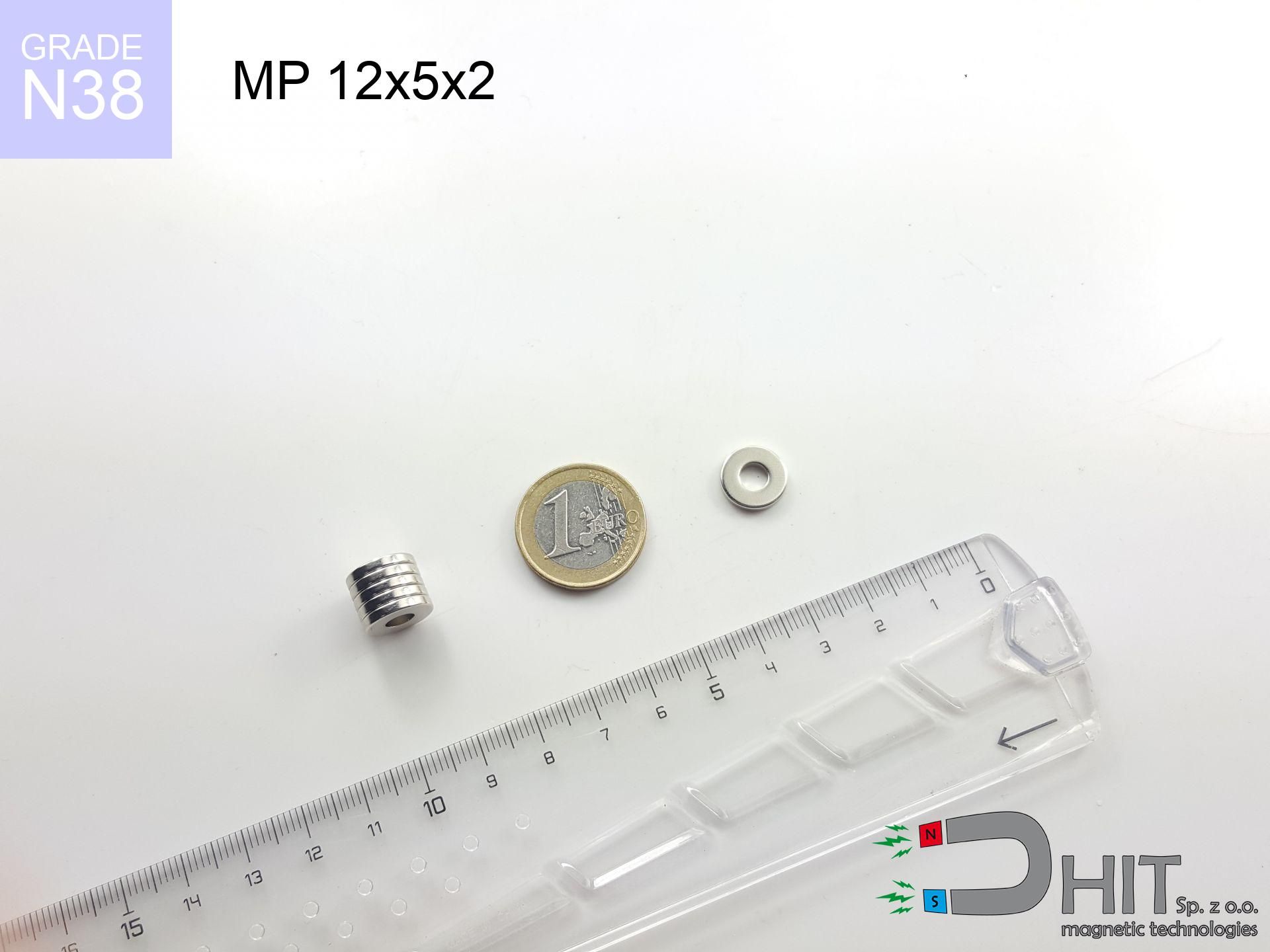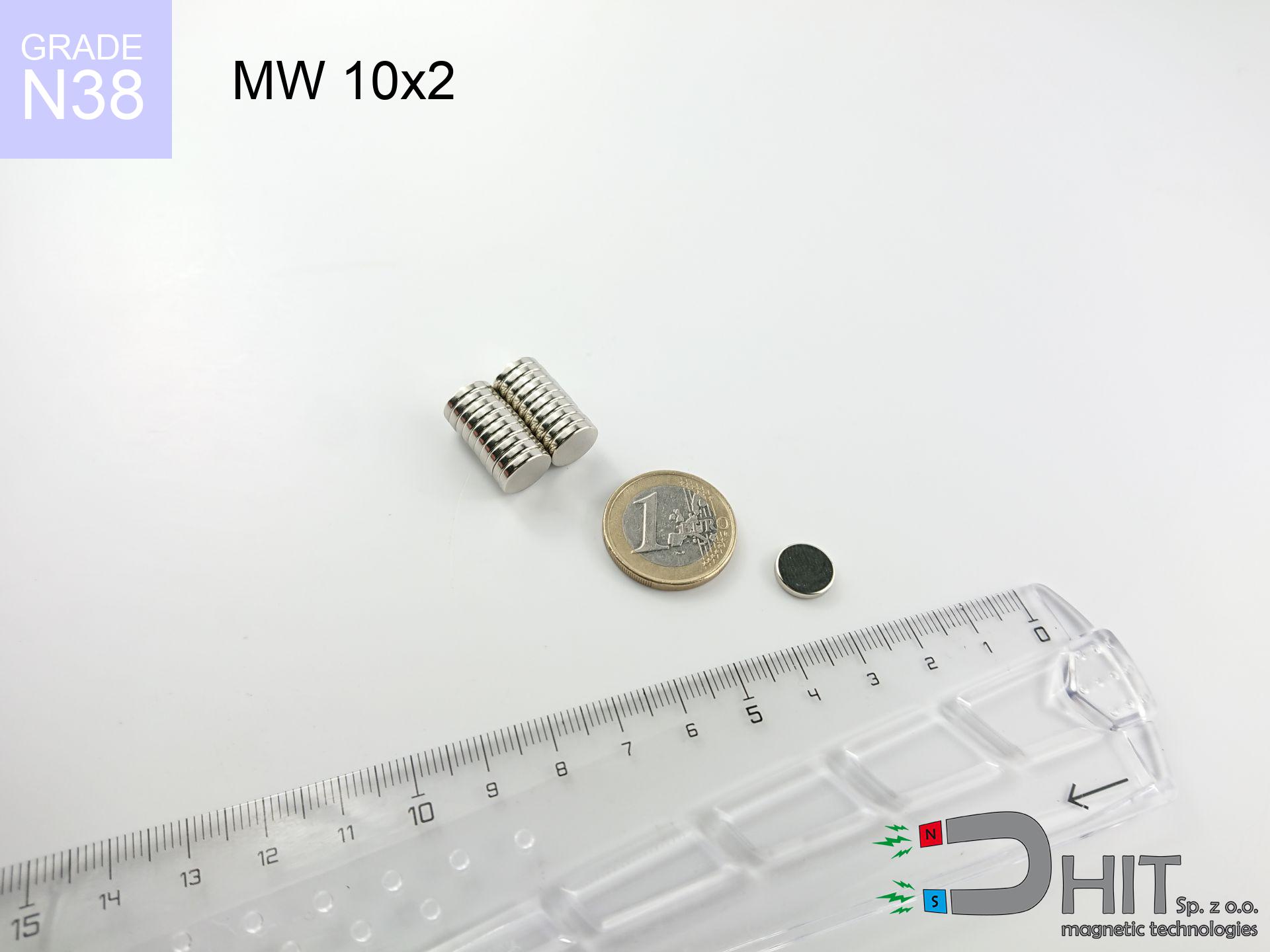MP 12x5x2 / N38 - ring magnet
ring magnet
Catalog no 030498
Diameter
12 mm [±0,1 mm]
internal diameter Ø
5 mm [±0,1 mm]
Height
2 mm [±0,1 mm]
Weight
3.3 g
Magnetization Direction
↑ axial
Magnetic Induction
190.54 mT
Coating
[NiCuNi] nickel
1.230 ZŁ with VAT / pcs + price for transport
1.000 ZŁ net + 23% VAT / pcs
bulk discounts:
Need more?Can't decide what to choose?
Give us a call
+48 888 99 98 98
alternatively drop us a message via
inquiry form
our website.
Lifting power along with structure of a magnet can be tested with our
modular calculator.
Orders submitted before 14:00 will be dispatched today!
Magnetic properties of material N38
Physical properties of sintered neodymium magnets Nd2Fe14B at 20°C
Shopping tips
Advantages as well as disadvantages of NdFeB magnets.
Besides their tremendous strength, neodymium magnets offer the following advantages:
- They virtually do not lose strength, because even after ten years the decline in efficiency is only ~1% (based on calculations),
- They have excellent resistance to weakening of magnetic properties as a result of opposing magnetic fields,
- Thanks to the smooth finish, the layer of nickel, gold-plated, or silver-plated gives an modern appearance,
- The surface of neodymium magnets generates a intense magnetic field – this is one of their assets,
- Made from properly selected components, these magnets show impressive resistance to high heat, enabling them to function (depending on their shape) at temperatures up to 230°C and above...
- Due to the possibility of free forming and customization to unique requirements, magnetic components can be modeled in a broad palette of shapes and sizes, which expands the range of possible applications,
- Key role in innovative solutions – they are commonly used in magnetic memories, electric motors, precision medical tools, also other advanced devices.
- Relatively small size with high pulling force – neodymium magnets offer high power in small dimensions, which allows their use in small systems
Disadvantages of neodymium magnets:
- At strong impacts they can crack, therefore we recommend placing them in steel cases. A metal housing provides additional protection against damage and increases the magnet's durability.
- NdFeB magnets lose strength when exposed to high temperatures. After reaching 80°C, many of them experience permanent drop of strength (a factor is the shape and dimensions of the magnet). We offer magnets specially adapted to work at temperatures up to 230°C marked [AH], which are extremely resistant to heat
- They oxidize in a humid environment - during use outdoors we suggest using waterproof magnets e.g. in rubber, plastic
- We suggest a housing - magnetic mechanism, due to difficulties in producing threads inside the magnet and complicated forms.
- Potential hazard resulting from small fragments of magnets pose a threat, if swallowed, which is particularly important in the aspect of protecting the youngest. Additionally, small components of these devices can be problematic in diagnostics medical in case of swallowing.
- Higher cost of purchase is one of the disadvantages compared to ceramic magnets, especially in budget applications
Detachment force of the magnet in optimal conditions – what contributes to it?
The specified lifting capacity represents the limit force, recorded under laboratory conditions, specifically:
- with the contact of a sheet made of low-carbon steel, ensuring maximum field concentration
- whose thickness reaches at least 10 mm
- with an ideally smooth contact surface
- without any clearance between the magnet and steel
- under axial force direction (90-degree angle)
- in stable room temperature
Key elements affecting lifting force
Bear in mind that the working load will differ subject to elements below, starting with the most relevant:
- Gap between surfaces – even a fraction of a millimeter of distance (caused e.g. by veneer or dirt) drastically reduces the pulling force, often by half at just 0.5 mm.
- Force direction – remember that the magnet has greatest strength perpendicularly. Under shear forces, the capacity drops drastically, often to levels of 20-30% of the nominal value.
- Plate thickness – insufficiently thick steel causes magnetic saturation, causing part of the flux to be wasted to the other side.
- Material composition – different alloys reacts the same. High carbon content worsen the interaction with the magnet.
- Smoothness – ideal contact is possible only on smooth steel. Rough texture create air cushions, weakening the magnet.
- Temperature influence – high temperature reduces pulling force. Exceeding the limit temperature can permanently damage the magnet.
* Lifting capacity testing was carried out on plates with a smooth surface of suitable thickness, under a perpendicular pulling force, in contrast under parallel forces the load capacity is reduced by as much as 5 times. Moreover, even a minimal clearance {between} the magnet and the plate decreases the lifting capacity.
Safe handling of neodymium magnets
Finger safety
Big blocks can crush fingers instantly. Never place your hand betwixt two strong magnets.
Dust explosion hazard
Combustion risk: Rare earth powder is explosive. Avoid machining magnets in home conditions as this may cause fire.
Electronic devices
Intense magnetic fields can destroy records on credit cards, HDDs, and other magnetic media. Maintain a gap of min. 10 cm.
Safe operation
Before use, read the rules. Uncontrolled attraction can destroy the magnet or hurt your hand. Think ahead.
Avoid contact if allergic
Warning for allergy sufferers: The nickel-copper-nickel coating consists of nickel. If an allergic reaction occurs, immediately stop handling magnets and use protective gear.
Health Danger
Individuals with a ICD have to keep an absolute distance from magnets. The magnetic field can disrupt the functioning of the implant.
Protective goggles
Neodymium magnets are ceramic materials, meaning they are very brittle. Impact of two magnets leads to them breaking into small pieces.
Heat sensitivity
Control the heat. Exposing the magnet to high heat will destroy its properties and pulling force.
No play value
Always store magnets away from children. Risk of swallowing is significant, and the effects of magnets clamping inside the body are tragic.
Keep away from electronics
Navigation devices and smartphones are highly susceptible to magnetism. Close proximity with a strong magnet can decalibrate the internal compass in your phone.
Security!
Need more info? Read our article: Are neodymium magnets dangerous?



![SM 18x100 [2xM5] / N42 - magnetic separator SM 18x100 [2xM5] / N42 - magnetic separator](https://cdn3.dhit.pl/graphics/products/sm-18x100-2xm5-pem.jpg)


![UMGGZ 34x6 [M4] GZ / N38 - rubber magnetic holder external thread UMGGZ 34x6 [M4] GZ / N38 - rubber magnetic holder external thread](https://cdn3.dhit.pl/graphics/products/umg-34x6-m4-gz-rad.jpg)

